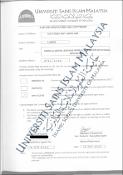Options
Tahfiz Al-Quran Learning Model For Students With Visual Impairement
Date Issued
2022-06
Author(s)
Nur Atiqah Abdul Aziz
Abstract
The al-Quran memorisation requires guidelines for devising a good memorisation strategy. The strategy must be determined based on the individual's suitability and ability. Without a sound memorisation strategy, the quality of memorisation and retention of the hafazan may be affected. This can be reflected in the difficulties that students with visual impairments have in mastering al-Quran. Among the contributing factors to the weakness of mastery is the use of ineffective and unsystematic methods in the teaching and learning techniques. The same goes to al-Quran memorisation context where the irregular and unsystematic method of memorisation will give a big impact to students in terms of their memory and effectiveness in memorising al-Quran. Therefore, this study aims to develop a tahfiz al-Quran learning model for SVI. The methodology used is the study of Design and Development Research. The objective of this study is to review the needs to the development of a tahfiz al-Quran learning model for SVI, to develop a tahfiz al-Quran learning model for SVI, and to evaluate the usability of the model developed. The study was conducted in three phases. Phase I of involved the needs analysis phase with semi-structured interview by approaching 7 educators and SVI. Phase II contained the development of the model using the Fuzzy Delphi Method (FDM) which involved the agreement of 17 respondents with experience of visual impairment tahfiz education and the tahfiz education among normal students. While phase III, the evaluation and the usability of the model involved 8 respondents among lecturers and tahfiz teachers who are directly involved with tahfiz education SVI. Nominal Group Technique is used to assess the usability and suitability of the model developed. The overall findings for phase I showed that there is consensus on the need to develop tahfiz al-Quran learning model for SVI. While the findings of phase II, the development of the model showed that all the constructs reached the consensus, which is over 75% agreement, with the value of "d" less than < 0.2 and defuzzication (Amax) exceeding > 0.5 as specified. Phase III of the study also showed a high acceptance among the respondents of the study on the usability of the model according to the percentage of score given which is equal or more than 70%. The development of tahfiz al-Quran learning model for SVI can be a guideline for undergoing the learning process in memorising al-Quran in accordance with their ability and capability in achieving the quality and effectiveness of tahfiz al Quran education
File(s)

Loading...
Name
4160268 Declaration.pdf
Size
254.32 KB
Format
Adobe PDF
Checksum
(MD5):9d04aa9678ebb87bed43dab26e5f6899
Loading...
Name
4160268 Introduction.pdf
Size
1.67 MB
Format
Adobe PDF
Checksum
(MD5):8818144a3216a663c179ea2b678f5763